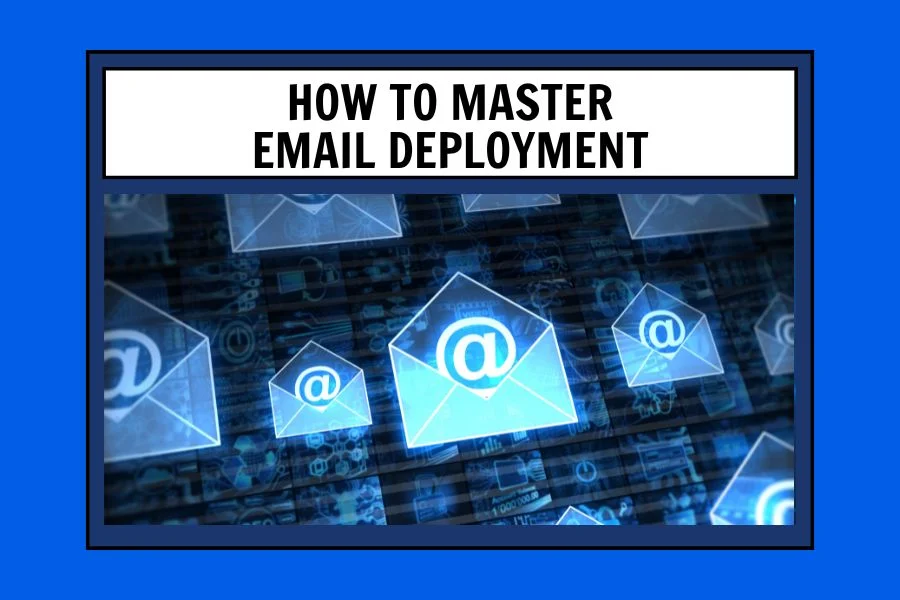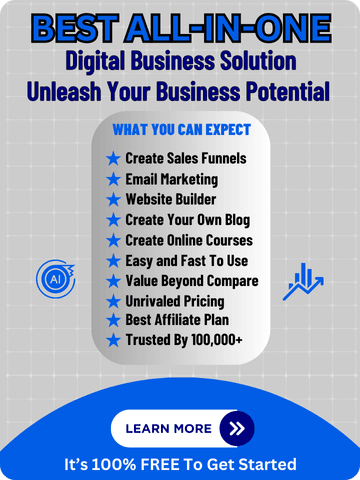Email deployment made simple: Discover tools, strategies, and best practices to boost your email marketing success and grow your digital business!
Introduction
Imagine having a direct line to your audience—a tool that lets you speak to thousands of potential customers at the click of a button. That’s the power of email deployment, a game-changing strategy for digital entrepreneurs like you. In a world where staying ahead means adapting to new tools and technology, mastering email deployment can transform your business and give you a competitive edge.
In this guide, you’ll uncover everything you need to know about email deployment, from its role in your marketing strategy to the best platforms to use. You’ll learn why it’s crucial for building lasting relationships with your audience, discover proven best practices to make your campaigns stand out, and explore metrics that measure success. Ready to take your email marketing to the next level? Let’s dive in!
Understanding Email Deployment
Definition of Email Deployment
At its core, email deployment is the process of strategically sending emails to a targeted audience to achieve specific goals, such as building relationships, promoting products, or nurturing leads. It’s not just about clicking “send”; it’s about ensuring the right message reaches the right person at the right time. Whether you’re trying to deploy email campaigns to grow your subscriber base or launch a new product, this approach sets the stage for success by combining technology and strategy.
How Email Deployment Fits Into Your Email Marketing Strategy
Think of email deployment as the engine that drives your email marketing strategy. Without a clear system to schedule, segment, and send your messages, your campaigns risk falling flat. A smart deployment process ensures that every email aligns with your business goals, whether it’s increasing sales, improving customer retention, or gathering valuable insights. From onboarding new customers with welcome emails to re-engaging past clients with exclusive offers, a solid deployment strategy ensures your emails work harder for you.
Key Features of Email Deployment Platforms
When it comes to deployment platforms, the features they offer can make or break your campaigns. Here are the essential tools you’ll want to leverage:
- Send Bulk Emails: Effortlessly reach thousands of subscribers without sacrificing deliverability or personalization.
- Segmentation: Divide your email list into targeted groups based on behavior, demographics, or purchase history to send relevant messages.
- Email Automation: Save time and increase efficiency by automating repetitive tasks, like sending welcome emails or birthday discounts. Before long, you’ll be able to direct your computer to respond to an email. Actually it’s already being tested—Computer Respond to this Email
- A/B Testing: Test different subject lines, content, or CTAs to see what resonates best with your audience.
- Personalization: Make every email feel tailor-made by using customer names, preferences, or purchase data.
- Analytics and Reporting: Track metrics like open rates, click-through rates, and conversions to measure success and fine-tune future campaigns.
- Deliverability Optimization: Ensure your emails land in inboxes, not spam folders, by using tools that improve sender reputation and email authentication.
- Integrations: Sync your email platform with CRM systems, e-commerce tools, and other software for seamless data management.
- Drag-and-Drop Email Editor: Design visually appealing emails with ease, even if you don’t have design experience.
- Responsive Design: Create emails that look great on any device, ensuring a consistent user experience across desktops, tablets, and smartphones.
Top 5 Email Deployment Platforms
Not all email deployment platforms are created equal, which is why it’s essential to choose one that aligns with your business needs. Here’s a comparison of the top five platforms:
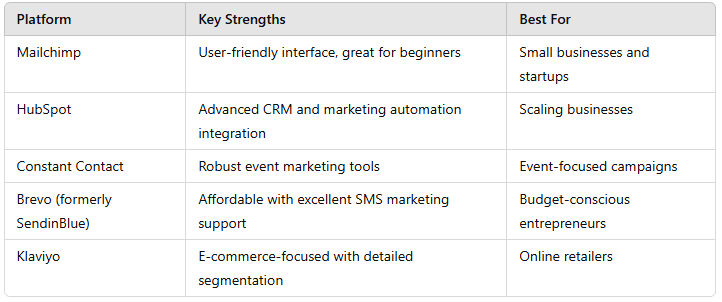
These platforms each offer unique features, ensuring you can choose the one that best supports your goals.
Now that you understand the fundamentals of email deployment and the tools available, it’s time to explore why mastering this strategy is essential for your success as a digital entrepreneur.
Why Email Deployment is Crucial for Digital Entrepreneurship
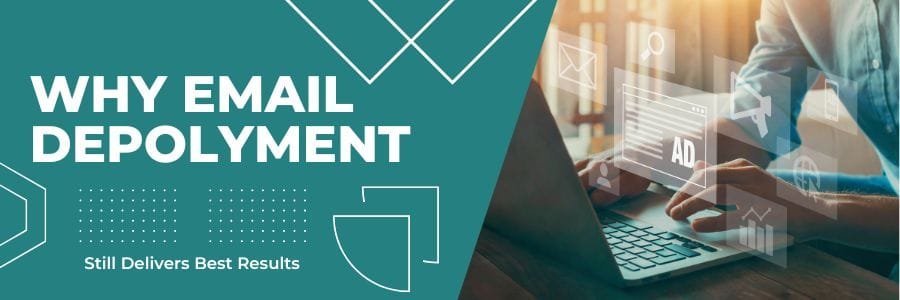
Highly Cost-efficient Way to Directly Reach a Large Audience
In a world where marketing budgets can spiral out of control, email deployment offers a refreshingly affordable solution to connect with your audience. Unlike paid ads or traditional media, email allows you to reach thousands—even millions—of people at a fraction of the cost. Plus, you’re not just throwing money at clicks or impressions; you’re building meaningful connections that drive results. Whether you’re sending newsletters, product updates, or exclusive offers, email remains one of the most cost-effective ways to scale your business and grow your customer base. Think about it: when else can you speak directly to your audience without a middleman?
Build Long Term Relationships and Gather Valuable Customer Data
The beauty of email deployment lies in its ability to nurture relationships over time. By consistently showing up in your subscribers’ inboxes, you’re reinforcing your brand and building trust. But it doesn’t stop there—email is also a goldmine for email data collection. From tracking open rates and clicks to gathering insights on customer preferences, every campaign gives you a deeper understanding of your audience. This data empowers you to craft more personalized and impactful messages, keeping your audience engaged and loyal. Ultimately, you’re not just sending emails—you’re creating lasting connections that fuel long-term success.
Understanding the “why” behind email deployment is just the beginning. Let’s dive into the best practices that will make your campaigns truly stand out.
Best Practices for Effective Email Deployment
Audience Segmentation
If you’re sending the same email to everyone on your list, you’re missing out on the magic of segmentation. By dividing your audience into smaller, targeted groups based on factors like demographics, purchase history, or engagement, you can make your emails more relevant and impactful. Effective segmentation in email deployment ensures you’re speaking directly to each subscriber’s needs and interests, boosting your email reach and campaign performance.
Compelling Subject Lines
Your subject line is the first impression your email makes—don’t let it fall flat. A compelling subject line grabs attention, sparks curiosity, and encourages the recipient to open the email. Keep it short, clear, and action-oriented while adding a touch of intrigue. Remember, no matter how great your content is, a poorly written subject line can render your efforts invisible.
Personalization Techniques
People crave personal connections, even in digital communication. Using personalization techniques in email deployment—like addressing subscribers by name or tailoring content to their preferences—can make your emails feel less like marketing and more like a conversation. Personalized emails show your audience that you understand their needs, which can lead to higher engagement and loyalty.
Email List Hygiene
A clean email list is a healthy email list. Regularly removing inactive or invalid email addresses improves deliverability and ensures your messages are reaching engaged subscribers. With proper email list hygiene, you reduce bounce rates, avoid spam complaints, and optimize your email reach for maximum impact.
Double Opt-In
The double opt-in process might seem like an extra step, but it’s worth it. By requiring subscribers to confirm their email address before joining your list, you ensure they’re genuinely interested in your content. This best practice reduces spam complaints, improves deliverability, and ensures your emails are welcomed rather than ignored.
Call-to-Action (CTA)
Every email you send should have a clear and compelling call-to-action (CTA). Whether it’s asking readers to shop a sale, download a guide, or sign up for an event, your CTA is the bridge between your email content and your goal. Use action-oriented language, make it visually distinct, and align it with the value you’re offering.
Email Frequency and Optimal Send Times
How often should you email your audience? Too much, and you risk annoying them. Too little, and they might forget about you. Finding the right balance for your audience and testing optimal send times can make a huge difference in engagement. Monitor metrics like open rates to determine when your audience is most responsive, and adjust your schedule accordingly.
By following these best practices, your email deployment campaigns will not only stand out but also deliver measurable results. Now, let’s take a closer look at how to track those results and continuously improve your strategy.
Measuring Email Deployment Success
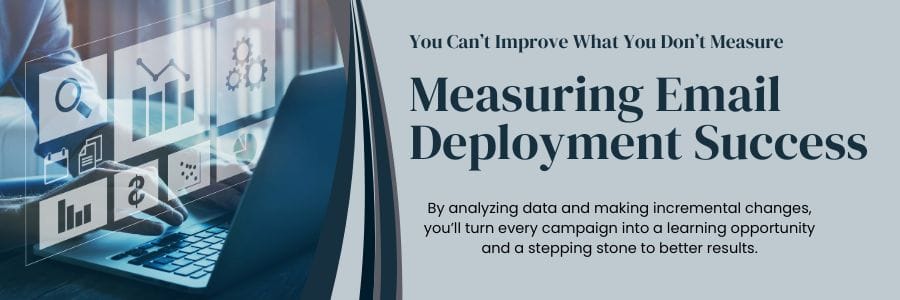
Key Metrics to Track
You can’t improve what you don’t measure. Tracking the right metrics is essential for evaluating the success of your email deployment campaigns. Start with your open rate—it tells you how many recipients actually opened your email, giving you insight into how engaging your subject lines are. Next, monitor your click-through rate (CTR), which shows how many people clicked on a link in your email. This metric helps you assess the effectiveness of your content and calls to action.
Don’t stop there—track your conversion rate, the ultimate measure of whether your email achieved its goal, whether it’s a sale, sign-up, or download. Pay attention to your bounce rate (the percentage of emails that couldn’t be delivered) and your unsubscribe rate (a warning sign that your content isn’t resonating). Keep an eye on your delivery rate to ensure your emails are reaching inboxes, not spam folders. Finally, your spam complaint rate is a critical metric; too many complaints can damage your sender reputation, making managing email effectively even harder.
How to Use A/B Testing and Other Data to Improve Future Campaigns
A/B testing is like a crystal ball for your email campaigns—it shows you what works and what doesn’t. By testing variables like subject lines, CTAs, or even email design, you can refine your email deployment strategy based on hard data, not guesswork. For example, you might test whether a button or text link generates more clicks or see if a shorter subject line gets better open rates.
Use the insights from A/B testing alongside your campaign metrics to continuously optimize your approach. Look at trends in your audience’s behavior, tweak your email content, and adjust your timing. By analyzing data and making incremental changes, you’ll turn every campaign into a learning opportunity and a stepping stone to better results.
Now that you know how to measure success, let’s explore the many types of email campaigns you can deploy to engage your audience and drive action.
Popular Types of Email Campaigns in Email Deployment
Welcome Emails
Your first impression matters, and a welcome email sets the tone for your relationship with new subscribers. This email should thank them for joining, introduce your brand, and highlight what they can expect moving forward. Keep it warm and engaging—think of it as a virtual handshake that leaves a lasting impression.
Abandoned Cart Emails
When customers leave items in their shopping carts, it’s an opportunity waiting to happen. Abandoned cart emails gently remind them of what they left behind and nudge them to complete their purchase. Add urgency with phrases like “Only a few left!” or sweeten the deal with a discount. Personalization and clear CTAs are key to converting hesitation into action.
Newsletters
Newsletters are the workhorses of email deployment. They keep your audience informed about updates, events, or valuable content like blog posts. To make them effective, focus on providing value rather than just promoting your products. Include a mix of information, tips, and links to keep readers engaged.
Seasonal Emails
Everyone loves a timely message. Seasonal emails are tied to holidays or key events, making them perfect for themed promotions or greetings. Use festive visuals and create a sense of occasion to make these emails feel special and relevant.
Transactional Emails
Transactional emails are functional yet powerful. Whether it’s a shipping update or a password reset, these messages keep your customers informed. Use them to build trust by ensuring they are clear, concise, and branded.
Confirmation Emails
An acknowledgement email like a confirmation is often the most-read email in any sequence. It reassures the recipient that their order, booking, or sign-up went through successfully. Include essential details and encourage follow-up actions like sharing on social media or exploring more of your offerings.
Lead Nurturing Emails
A nurture sequence is your secret weapon for turning leads into loyal customers. These emails educate, inspire, and build trust over time. Use storytelling, case studies, or tutorials to position yourself as the solution to your audience’s challenges.
Promotional Emails
Promotional emails are your direct sales drivers. Use these emails to highlight special offers, limited-time discounts, or new product launches. Make your CTAs bold and enticing, and use visuals that showcase the value of your offer.
Announcement Emails
Have big news? An announcement email is your megaphone. Whether it’s a product launch, a milestone, or an exciting partnership, use this email to generate buzz. Keep the tone celebratory and include a clear CTA to direct readers to learn more.
Survey Emails
Want to understand your audience better? A survey email is your gateway to valuable feedback. Keep the survey short and include an incentive to boost responses. Use this feedback to improve your products, services, and future campaigns.
Now that you’ve explored the many ways to engage your audience with email, let’s recap the key takeaways and dive into some surprising stats that show the true power of email deployment.
Closing
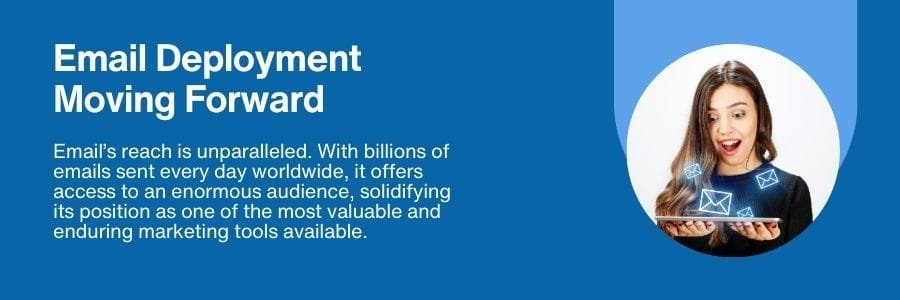
Recap – Moving Forward
By now, you’ve discovered how email deployment can revolutionize your digital business. From understanding its role in your marketing strategy to mastering best practices and exploring diverse email types, you’re equipped with the tools to engage your audience effectively. Whether it’s crafting personalized emails, analyzing key metrics, or building lasting customer relationships, every aspect of your strategy contributes to driving measurable results. With these insights, you’re ready to harness the power of email to grow your business and stay ahead of the competition.
Surprising Fact
Did you know that for every dollar spent on email marketing, the average ROI is $36? That’s a staggering return on investment, making email deployment one of the most profitable strategies for digital entrepreneurs. In fact, it outperforms many other marketing channels, proving that a well-executed email campaign can be a cornerstone of your business success.
FAQs: Email Deployment
How often should I send emails to my subscribers?
The frequency of your emails depends on your audience and the value you’re offering. Generally, aim to send at least one email per week to stay top of mind without overwhelming your subscribers. Pay attention to engagement metrics—like open and unsubscribe rates—to find the sweet spot. Regular email deployment keeps your audience engaged while allowing you to build a lasting connection.
What’s the difference between email delivery and email deliverability?
Email delivery refers to whether your email reaches the recipient’s email server, while email deliverability focuses on whether it lands in the inbox or gets flagged as spam. A successful email deployment strategy ensures high deliverability by maintaining list hygiene, using proper authentication protocols, and crafting relevant, valuable content.
How can I improve my email open rates?
Improving open rates starts with creating compelling subject lines that spark curiosity or urgency. Segment your audience to ensure your message resonates with their interests, and always test optimal send times. Additionally, make sure your sender name is recognizable—people are more likely to open emails from a trusted source. A/B testing can be a game-changer in refining these elements.
How do I avoid my emails being marked as spam?
To avoid the spam folder, always get permission before sending emails and use a verified sender domain. Keep your content relevant and avoid excessive use of spammy words like “free” or “guaranteed.” Focus on delivering value and maintaining good list hygiene by removing inactive or invalid addresses. Tools within email deployment platforms often include spam checks to help you stay compliant.
What’s the difference between email plain text vs HTML?
The primary difference between email plain text vs HTML lies in the presentation. Plain text emails contain only text—simple, straightforward, and easy to read on any device. HTML emails, however, include design elements like images, buttons, and colors, allowing for a more branded and visually appealing look. Use plain text for personal communication or updates and HTML for marketing campaigns where visuals can enhance the message. Both have their place in a robust email deployment strategy.
What are some common email deployment mistakes to avoid?
Even the best intentions can lead to mistakes in email deployment if you’re not careful. One major pitfall is sending emails to an unsegmented list—this can result in irrelevant messages that frustrate your subscribers. Another common error is neglecting to test your emails before sending them. Broken links, formatting issues, or images that don’t load can damage your credibility. Overloading your audience with too many emails is also a surefire way to increase unsubscribe rates.
Failing to comply with GDPR or other privacy laws, such as not including an easy opt-out option, can lead to legal troubles. Additionally, skipping A/B testing means you’re missing out on opportunities to optimize your campaigns. Always prioritize quality over quantity and keep your audience’s needs front and center to avoid these mistakes.
Attention Digital Entrepreneurs
Are you a digital entrepreneur looking to elevate your business with email marketing? Check out this FREE All-In-One Digital Business Solution: [JOIN HERE FOR FREE]

